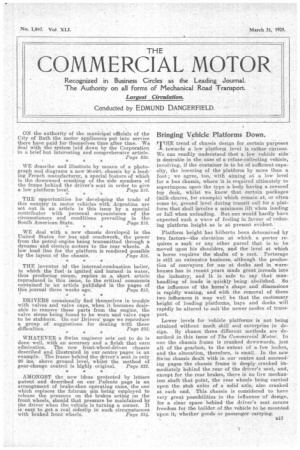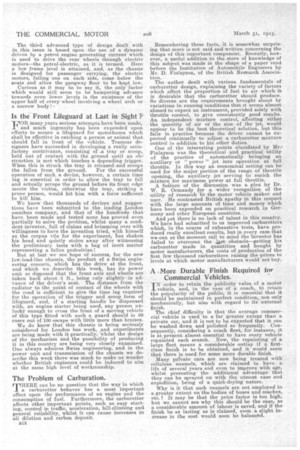Bringing Vehicle Platforms Down.
Page 1

Page 2

If you've noticed an error in this article please click here to report it so we can fix it.
rilHE trend of chassis design for certain purposes
towards a low platform level is rather curious. We can readily understand that a low vehicle side is desirable in the case of a refuse-collecting vehicle, involving, if the container is to be of sufficient capacity, the lowering of the platform by more than a foot; we agree, too, with aiming at a low level for a bus chassis, where it is required ultimately to superimpose upon the type a body having a covered top deck, whilst we know, that certain packages (milk-churns, for example) which remain at, or often come to, ground level during transit call for a platform that shall involve a minimum lift when loading or fall when unloading. But one would hardly have expected such a wave of feeling in favour of reducing platform height as is at present evident.
Platform height has hitherto been determined by two factors—the elevation at which a porter requires a seek or any other parcel that is to foe moved upon his shoulders, and the level at which .a horse. requires the shafts of a cart. Porterage is still an extensive business, although the production of conveyors for use at clocks and in warehouses has in recent years made great inroads into the industry, and it is safe to say that manhandling of loads is quickly being abolished. So the influence of the horse's shape and dimensions is rapidly waning, and with the removal of these two influences it may well be that the customary height of loading platforms, bays and docks will rapidly be altered to suit the newer modes of transport. Lower level for vehicle platforms is not being attained without much skill and enterprise in design. By chance three different methods are described in this issue of The Commercial Motor. In one the chassis frame is cranked downwards, just aft of the gearbox, to the extent of a few inches, and the alteration, therefore, is small. In the new Swiss chassis dealt with in our centre and succeeding pages the chassis frame is deeply cranked immediately behind the rear of the driver's seat, and, except for the rear brakes, there is no live mechanismeabaft that point, the rear wheels being carried upon the stub axles of a solid axle, also cranked at each end. This chassis is considered to have very great possibilities in the influence of design, for a clear space behind the driver's seat _means freedom for the builder, of the vehicle to be mounted Upon it whether goods Or passenger carrying.
The third advanced type of design dealt with in this issue is based upon the use of a dynamo driven by a petrol engine generating current which is used to drive the rear wheels through electric motors—the petrol-electric, as it is termed. Here a low frame level is attained, and, as the chassis is designed for passenger • carrying, the electric motors, falling one on each side, come below the seats and allow the gangway floor to be kept low. Curious as. it may be to say it, the only factor which would still seem to be hampering advance towards even lower levels is the existence of the upper half of every wheel involving a wheel arch or a narrow body !
Is the Front Lifeguard at Last in Sight ?
OR many years serious attempts have been made, and much ingenuity has been expended upon efforts to secure a lifeguard for motorbuses which shall be effective in catching a person or animal that should fall in front of the vehicle. Tramcar designers have succeeded in developing a really satisfactory contrivance, consisting of .a tray or scoop, held out of contact with the ground mita an strection is met which touches a depending trigger. When this is struck the tray is released and scoops the fallen from the ground. For the successful operation of such a device, however, a certain time lag is essential in order to allow the tray to fall and actually scrape the ground before its front edge meets the victim, otherwise the tray, striking a prone person, would hit him with a force sufficient to kill him.
We know that thousands of devices and suggestions have been submitted to the leading London omnibus company, and that of the hundreds that have been made and tested none has proved even partially to solve the problem, whilst many a, confident inventor, full of claims and brimming over with willingness to have the invention tried, with himself as the corpus vile for the experiment, has shaken. his head and quietly stolen away after witnessing the preliminary tests with a bag of inert matter representing a fallen pedestrian!
But at last we see hope of success, for the new low-load-line chassis, the product of a Swiss engineering concern, which has the drive at the front, and which we describe this week, has its power unit so diaposed that the front axle and wheels are taken back about 3 ft., being only slightlyin advance of the driver's seat. The distance from the radiator to the point of contact of the wheels with the road is sufficient to give the time lag required for the operation of the trigger and scoop form of lifeguard, and, if a starting handle be dispensed with, an engine starter being used, any person unlucky enough to cross the front of a moving vehicle of this type fitted with such a guard should in 99 cases out of 100 escape with little more than bruises.
We do know that this chassis is being seriously considered for London bus work, and experiments are being made with it practically, whilst the design of the mechanism and the possibility of producing it in this country are being very closely examined. One always admires Swiss engineering, and in the power unit and transmission of the chassis we describe this week there was much to make us wonder whether British engineers could be induced to aim at the same high level of workmanship.
The Problem of Carburation.
THERE can be no question that the way in which a carburetter behaves has a most important effect upon the performance of an engine and the consumption of fuel. Furthermore, the carburetter affects other important points, such as easy starting, control in traffic, acceleration, hill-climbing and general reliability, whilst it can cause increases in oil dilution and carbon deposit.
B18 Remembering these facts, it is somewhat surprising that more is not said and written concerning the design of this important component. Recently, how ever, a useful addition to the store of knowledge of this subject was made in the shape of a paper read before the Institution of Automobile Engineers by Mr. D. Finlayson, of the British Research Association.
The author dealt with various fundamentals of carburetter design, explaining the variety of factors which affect the proportion of fuel to air which it is desirable that the carburetter should produce. So diverse are the requirements brought about by variations in running-conditions that it seems almost absurd to expect an instrument, provided solely with throttle control, to give consistently good results. An independent mixture control, affecting either the quantity of air or the size of the jet, would appear to be the best theoretical solution, but this failsin practice because the driver cannot be expected continually to adjust a carburetter mixture control in addition to his other duties.
One of the interesting points elucidated by Mr., Finlayson was the theoretical and practical utility of the practice of automatically bringing an auxiliary or "power " jet into .operation at full throttle. In this way an economical setting can be used for the major portion of the range of throttle opening, the auxiliary jet serving to enrich the mixture for maximum power at full throttle.
A feaure of the discussion was a plea by Dr. W. It. Ormandy for a. wider recognition of the utility of research to the motor vehicle maker and user. He contrasted British apathy in this respect with the large amounts of time and money which have been expended on practical research in Germany and other European countries. And yet there is no lack of talent in this country. We have had submitted to us improved carburetters which, in the course of exhaustive tests, have produced really excellent results, but in every case that wecan at the moment call to mind the inventor has failed to overcome the last obstacle—getting his carburetter made in quantities and bought by motor manufacturers, the costs of production of the first few thousand carburetters raising the prices to levels at which motor manufacturers would not buy.
A -More Durable Finish Required for Commercial Vehicles.
IN order to retain the publicity value of a motor vehicle, and, in the case of a coach, to retain the popularity of the public, it is essential that it should be maintained in perfect condition, not only mechanically, but also with regard to its external finish.
The chief difficulty is that the average commercial vehicle is used to a far greater extent than a. private car, and it is not to be expected that it can be washed down and polished so frequently. Consequently, considering a coach fleet, for instance, it is at present almost essential to have every vehicle repainted each season. Now, the repainting of a large fleet means a considerable outlay if a firstclass finish is to be obtained, and it would seem that there is need for some more durable finish.
Many private cars are now being treated with cellulose enamels, which are claimed to have a life of several years and even to improve with age, whilst presenting the additional advantage. that they can be sprayed on with the utmost ease and expedition, being of a quick-drying nature.
Why is it that such enamels are not employed to a greater extent on the bodies of buses and coaches, etc. ? It may be that the price factor is too high, but we cannot see why this should be the case, as a considerable amount of labour is saved, and if the finish be as lasting as is claimed, even a slight increase in the eost would soon be balanced.




























